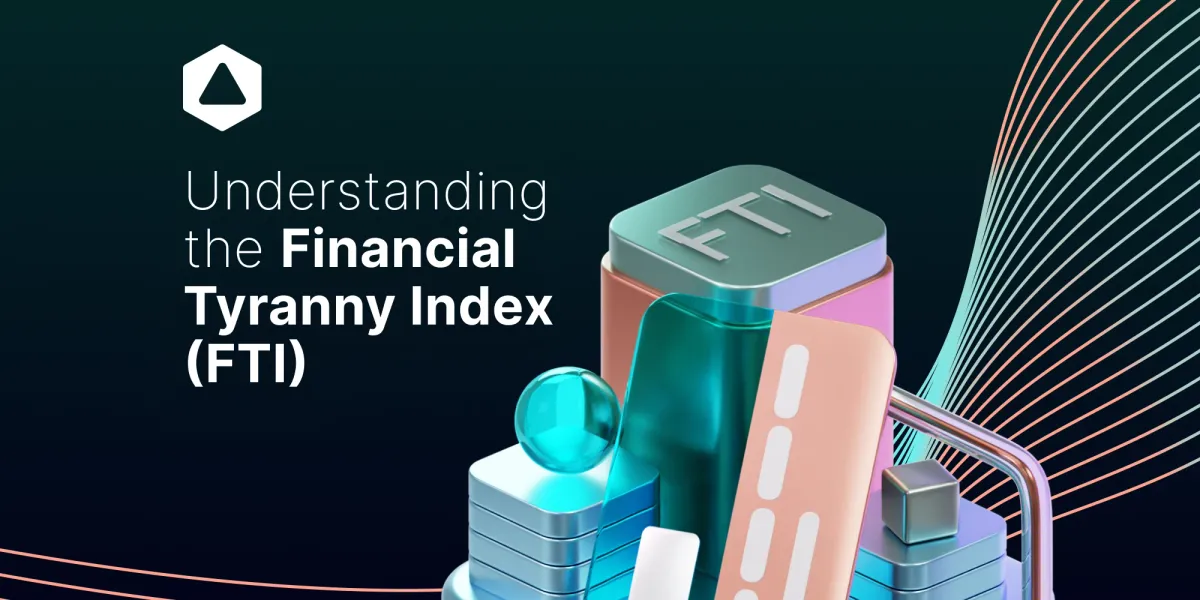Navigating the Financial Landscape: Understanding the Financial Tyranny Index (FTI)
We delve into the parameters used in the FTI and explore the current status of CBDCs worldwide, the legal status of cryptocurrencies, and cash transaction limits in the EU. By understanding these parameters, users can stay ahead of the evolving financial landscape.

In today's world, financial freedom and privacy are becoming increasingly important; especially with the rise of digital currencies and the increasing involvement of governments in financial affairs. This is where the Financial Tyranny Index (FTI) comes in. Created by the Vexl Foundation, the FTI is a comprehensive tool that measures the level of statist interventions in the financial space by combining various parameters. In this article, we will explore the parameters used in the FTI and how they can help users understand the current state of the financial landscape.

Parameters used in the FTI
The FTI uses several parameters to measure the level of financial intervention, including the legal status of cryptocurrencies, the cash transaction limit, personal income tax, social security rate, money supply growth and the status of central bank digital currencies (CBDCs).
Current status of CBDCs worldwide
The current status of CBDCs worldwide can be tracked through the CBDC Tracker, an open-source project that provides a comprehensive information resource for CBDC initiatives. The CBDC Tracker includes information on the status of CBDC projects in various countries, including those that have canceled or decommissioned a CBDC, those that have conducted first explanatory research, those that are in an advanced research stage and have published a proof of concept, those that have developed a CBDC that is tested in a real environment, and those that have officially fully launched a CBDC.
😔 Jamaica, the Bahamas, and Nigeria are among the countries that have already launched their own CBDCs, with the Bank of Jamaica launching its digital currency in 2023, the Bahamas launching the Sand Dollar in 2017, and the Central Bank of Nigeria introducing the e-Naira.
😊Many other countries are planning to launch their own CBDCs, including Canada, the United Arab Emirates, Saudi Arabia, Uruguay, India, Ghana, China, France, Tunisia, and Singapore. These countries recognize the potential of CBDCs to revolutionize the financial landscape and increase financial inclusion for individuals in underdeveloped financial systems.
😍 Some countries have cancelled their plans for launching their own digital currencies. Denmark, Singapore, the Philippines, Haiti, Ecuador, and Finland have all cancelled their CBDC plans.
Legal Status of Cryptocurrencies
The legal status of cryptocurrencies varies substantially from one jurisdiction to another, and is still undefined or changing in many of them. While some states have explicitly allowed its use and trade, others have banned or restricted it. Various government agencies, departments, and courts have classified cryptocurrencies differently. In Europe, cryptocurrency is generally more widely accepted than in other regions.
💖 The countries that score highest in crypto adoption are El Salvador, Fiji, Tonga (a country in Polynesia), and the Central African Republic. These countries have plans to make cryptocurrency their legal tender.
💔Hostile environments include China, Morocco, Egypt, Algeria, Bangladesh, Afghanistan, Bolivia, and Nepal. It's best to avoid these countries if you're fond of cryptocurrencies.
Cash transaction limits in the EU
Cash payment limitations vary across the EU, and entering or leaving a country with cash may be subject to customs declarations. Therefore, it is advised to check the methods of payment accepted by traders and ensure that transactions are as secure as possible if you want to on/off-ramp your cryptocurrency. That's why we take a closer look at the most friendly and unfriendly European countries for cryptocurrency transactions
💸There are no limits for paying with cash in several European countries, including Cyprus, Austria, Estonia, Finland, Germany, Iceland, and Luxembourg.
🔒The cash transaction limit is particularly low in Greece and Italy, with a limit of €500 and €1000, respectively.
Personal Income Tax Rate
Personal income tax rate is the percentage of an individual's income that is paid to the government as tax, and this rate varies significantly across countries. For crypto enthusiasts, it is important to know which countries make it favorable to cash out and which ones do not.
⬆️Finland has the highest personal income tax rate globally at 56.95%, followed by Denmark and Japan with rates of 56% and 55.97%, respectively.
⬇️Conversely, some countries have a 0% personal income tax rate, including the Bahamas, Bahrain, Bermuda, Brunei, Cayman Islands, Kuwait, Oman, Qatar, Saudi Arabia, and the United Arab Emirates.
Living in countries with a 0% personal income tax rate could be advantageous for some who want to maximize their take-home pay or reduce their tax burden.
Social Security Rate
The social security rate refers to the percentage of an employee's income that is withheld to contribute towards Social Security benefits.
When we compare social security rates across the world, we can see the following analysis:
🤒France has the highest social security rate globally at 68%, followed by the Netherlands with a rate of 51.24%. Other countries with high social security rates include Slovakia at 48.6%, Belgium at 48.07%, and the Czech Republic at 44.8%.
🏋️♂️Denmark and Qatar have a 0% social security rate. South Africa also has a 0% social security rate, but it is not listed in the same format as the others.
Money Supply Growth (TTM %)
Money supply growth (TTM %) measures the annualized rate of increase in the total money supply within an economy. It compares the current money supply with the supply 12 months ago, expressing the difference as a percentage of the initial supply. TTM stands for 'trailing twelve months.'
High money supply growth can fuel inflation if the money grows faster than the goods and services it can buy. Excess money supply growth therefore poses risks for price stability and economic health.
💸Several countries have experienced extreme money supply growth in recent years, leading to soaring inflation and economic problems. Venezuela saw 58.8% growth in 2013, Turkey 60.3% in 2022, Argentina 84.9% in 2022, Sudan 88% in 2020, Somalia a staggering 162.8% in 1989, and Zimbabwe 391.9% in 2022. Their inflation rates skyrocketed into the triple digits, currencies lost value rapidly, and citizens faced economic hardship.
It is best to avoid countries with extremely high money supply growth if you value keeping your gains stable.
Conclusion
The Financial Tyranny Index provides a valuable tool for understanding the state of financial intervention and regulation around the world. By monitoring parameters such as CBDC status, cryptocurrency legality, cash transaction limits, personal income tax, social security rate and money supply growth, all cryptocurrency users can make informed decisions. As the financial landscape continues to evolve, tools like the FTI will become increasingly important for navigating the complex world of finance and ensuring financial freedom and privacy.

Connect with Bitfinity Network
Bitfinity Wallet | Bitfinity Network | Twitter | Telegram | Discord | Github

*Disclaimer: While every effort is made on this website to provide accurate information, any opinions expressed or information disseminated do not necessarily reflect the views of Bitfinity itself.





Comments ()